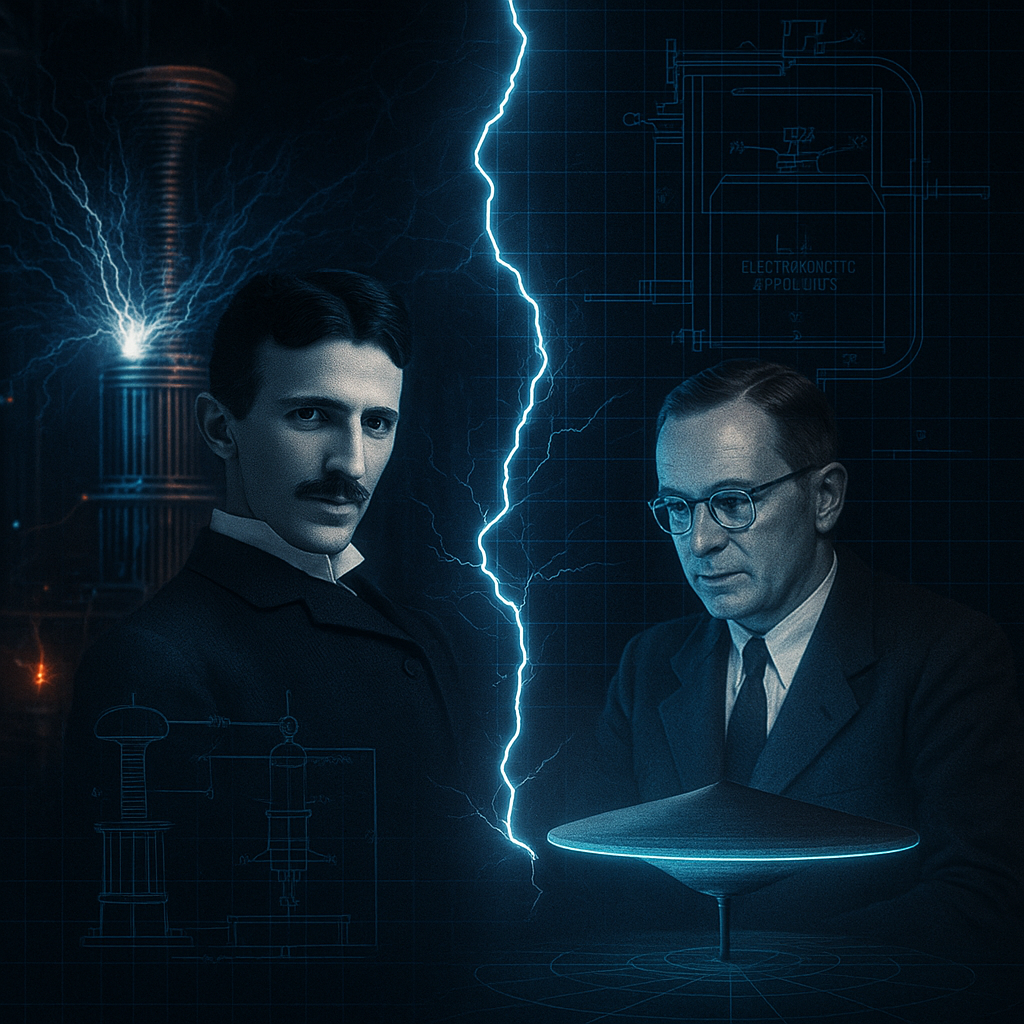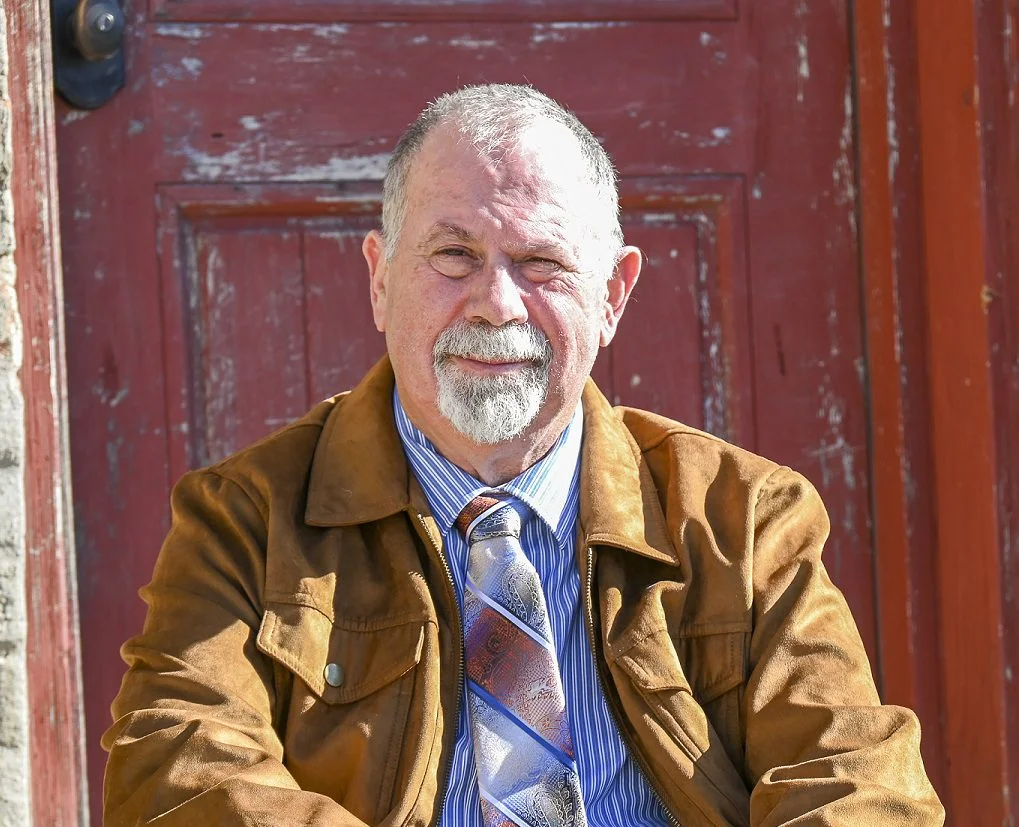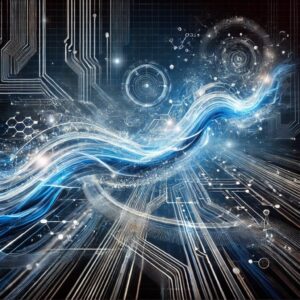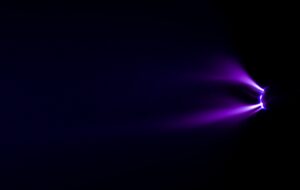At a Glance: Townsend Brown and Nikola Tesla in Perspective
The story of Townsend Brown and Nikola Tesla reveals a continuity of ideas about motion, high voltage, and propulsion that stretches across the 20th century. Tesla’s early visions of wireless power and electromagnetic propulsion laid groundwork that Brown would later expand into electrogravitics. Alongside other inventors such as George Piggot and Robert Goddard, their discoveries challenged conventional physics and hinted at untapped forces.
Read time: 6 minutes
Townsend Brown and Nikola Tesla: Introduction
The debate over who first connected electricity and motion to practical propulsion is more than historical curiosity. Tesla’s bold statements in 1905 about achieving dirigible speeds over 200 miles per hour through electromagnetic thrust were dismissed by many. Three decades later, Brown’s experimental work with capacitors revived the question in new ways. Together, Townsend Brown and Nikola Tesla demonstrate that scientific progress often follows overlapping paths, where vision and persistence reshape what is possible.
Tesla’s Early Exploration of Propulsion

In 1905, Nikola Tesla published an article in The Atlantic describing how electromagnetic forces might accelerate airships beyond 200 miles per hour. Though his claim drew skepticism, the idea foreshadowed later breakthroughs. Rumors in the 1930s suggested Tesla collaborated with the U.S. Navy on revolutionary propulsion systems, though proof has never surfaced. What remains clear is Tesla’s deep conviction that high-voltage, wireless energy could transform transportation.
Other Early Innovators: Piggot and Goddard
The years after Tesla saw other inventors exploring related ideas. George Piggot’s 1911 patent for “Space Telegraphy” demonstrated electrostatic levitation, with steel balls suspended between high-voltage terminals. In 1920, Robert Goddard patented an electrostatic rocket thruster—an early concept that anticipated later NASA propulsion systems. These pioneers illustrate that the quest for propulsion through electric fields was a shared frontier, not a single-person pursuit.
Townsend Brown and the Birth of Electrogravitics
Townsend Brown’s journey began as a teenager experimenting with X-ray Coolidge tubes. By 1923, after a brief stint at Caltech where his ideas were dismissed, he found a mentor in Dr. Paul Biefeld at Denison College. With Biefeld’s encouragement, Brown filed his first patents and articulated what became known as the Biefeld-Brown Effect—the principle that capacitors under high voltage could produce thrust. Brown dedicated his life to proving this effect, moving from small demonstrations to full-scale designs.
Patents, Prototypes, and Persistence
Brown’s patents chart a progression of bold experimentation. His 1930 electrostatic motor and generator laid the foundation. His most famous work, the 1960 U.S. Patent 2,949,550 for an “Electrokinetic Apparatus,” described saucer-like craft powered by high-voltage capacitors. Other patents, including electrokinetic transducers and flame-jet generators, expanded the field. Backed by financier Agnew Bahnson in the late 1950s, Brown and his collaborators pursued gravity-control research that resulted in additional patents.
Legacy and Modern Replications
Brown’s influence extends well beyond his lifetime. His patents have been cited by hundreds of inventors, and modern researchers continue to test his theories. Dr. Buhler and Andrew Arigema of Exodus Space Technologies patented a system using electrostatic pressure, while Mark Sokol of Falcon Space confirmed Brown’s apparatus in vacuum tests. Just as Tesla’s visions were revisited decades later, Brown’s persistence has inspired a new generation to explore electrogravitics.
“The scientists of today think deeply instead of clearly. One must be sane to think clearly, but one can think deeply and be quite insane.” – Nikola Tesla
What We Know About Townsend Brown and Nikola Tesla as Pioneers of Energy in Motion
Looking back, the connection between Townsend Brown and Nikola Tesla shows that innovation rarely occurs in isolation. Tesla’s wireless energy concepts, Piggot’s levitation patents, Goddard’s thrusters, and Brown’s electrogravitics form a chain of inquiry. Each inventor pushed against limits of accepted science, often at great personal cost, but their collective work hints at new paradigms for energy and motion.
If Tesla’s and Brown’s breakthroughs were taken seriously in their own time, how different might our approach to energy and propulsion look today?
From Unanswered Questions About Townsend Brown and Nikola Tesla to Unfinished Work
The stories of Townsend Brown and Nikola Tesla leave us with more questions than answers. Their discoveries sparked possibilities that remain unfinished and now, in a time of rapid innovation, researchers have more tools and pathways than ever to pick up where they left off. From advanced materials to powerful modeling software, from collaborative forums to live lab replications, the pursuit of electrogravitics is entering a new era. The question is no longer whether the work can continue, but how boldly we choose to develop it.
If you’re designing an experiment, attempting a replication, or exploring a theory in electrogravitics, I understand how complex and rewarding this kind of work can be. Whether you’re building on Townsend Brown’s foundations or charting your own path, you don’t have to work in isolation. I offer mentorship and project guidance for those pursuing serious studies in this field. From reviewing concepts to refining experimental setups, I’m here to support those who are putting in the time to test, question, and explore.
📩 Reach out at 👉 letstalk@larrydeavenport.com or schedule a time to talk if a conversation would help clarify your direction.
No matter where you’re starting from, your work matters. Let’s make sure it has the best chance to move something forward.
About the Author

Larry Deavenport is a researcher, speaker, and educator with more than 40 years of experience exploring the frontier of electrokinetics, which he calls energy in motion. As founder of Deavenport Technology, he is dedicated to equipping innovators, researchers, and engineers with the clarity, tools, and mentorship they need to transform scattered theories into working prototypes.
Larry’s work focuses on bridging the gap between curiosity-driven experimentation and practical application. His teaching combines structured principles, hands-on demonstrations, and one-on-one guidance to help learners refine breakthroughs and accelerate discoveries. Through his keynotes, workshops, mentoring programs, and his two signature master courses, Larry inspires a new generation of pioneers to explore advanced gravitics and motion-based energy systems that align with natural forces and reduce environmental impact.
Passionate about both discovery and education, Larry continues to share his research and insights at conferences, in collaborative forums, and through his growing platform at Deavenport Technology. His mission is to guide bold thinkers who are ready to move from possibility into progress, shaping the future of sustainable energy and redefining what is possible.
References
- 1. Townsend Brown & Electrogravitics
U.S. Patent 2,949,550 – Electrokinetic Apparatus (1960): Townsend Brown’s most famous patent describing saucer-like craft using high-voltage capacitors. Patents.Google
U.S. Patent 3,022,430 – Electrokinetic Generator (1962): Flame-jet generator design to produce electrostatic force. Patents.Google
U.S. Patent 1,974,483 – Electrostatic Motor and Generator (1934): Early development of Brown’s gravitator concept. Patents.Google
“Force on an Asymmetric Capacitor” (Bahder & Fazi, U.S. Army Research Laboratory, 2002): Analytical paper evaluating the physics of Brown’s capacitor effect. arXiv.org
“An Analysis of the Brown–Biefeld Effect” (Valone, 2010): Peer-reviewed study confirming capacitor thrust direction and attributing cause to ion drift. arXiv.org - Nikola Tesla & Early Propulsion Concepts
Tesla, Nikola. “The Transmission of Electrical Energy Without Wires.” The Electrical World and Engineer, March 5, 1904. Early published article outlining his ideas for wireless energy and propulsion. Online Archive PDF
“The Advance of Wireless” (New York Times, September 1905): Report summarizing Tesla’s wireless energy proposals, including implications for transport speed. Early Radio History Archive - Other Early Innovators
George Piggot – U.S. Patent 1,006,789 “Space Telegraphy” (1911): Demonstrated electrostatic levitation effects with high-voltage terminals. Patents.Google
Robert Goddard – U.S. Patent 1,363,037 “Rocket Apparatus” (1920): Patented electrostatic rocket thruster concepts later adapted by NASA. Patents.Google - Modern Replications
Exodus Space Technologies – WO20159603A2 “System and Method for Generating Forces Using Electrostatic Pressure” (2015): Modern patent applying electrogravitic principles. Patents.Google
Falcon Space LLC – Experimental Replications: Mark Sokol’s published replication attempts of Townsend Brown’s electrokinetic apparatus in vacuum conditions. Falcon Space Lab Reports



